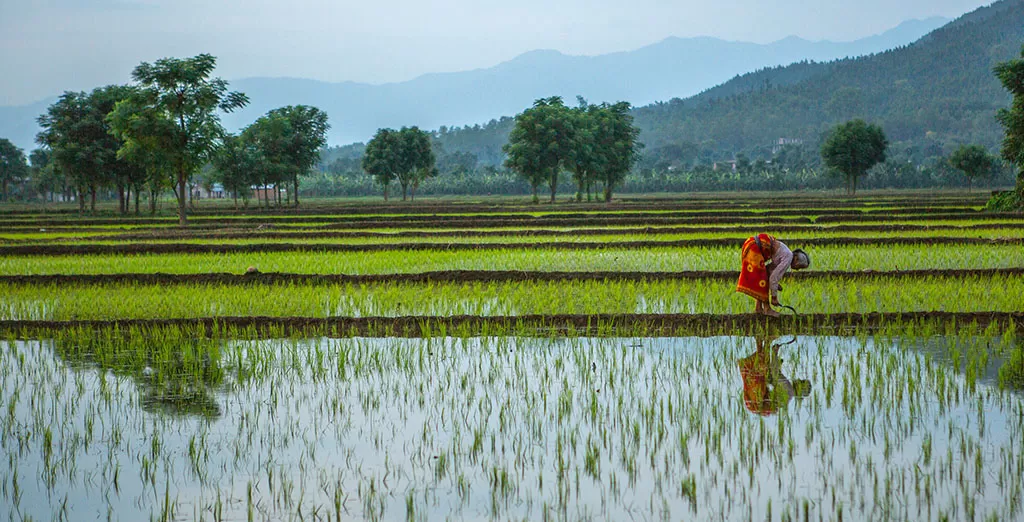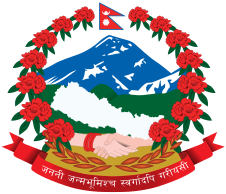Rice Plantation festival in Nepal

Nepal is dominated by agriculture. More than 60% of the people of Nepal depend on agriculture-based professions. The “rice planting festival” of Nepal is one of the country’s most important monsoon seasons, which marks the first planting of the premier staple crop. This festival is celebrated on the 15th of Ashar (June 29th this year) of the Nepali calendar every year as a tradition of Nepalese culture. The fifteenth of Ashar is the day when the crop planting season officially begins.
On the festival day, all over the farm, they get together at their paddy field, where ladies plant the rice and gentlemen plow the field to make the land suitable for planting the paddy. The Rice Planting Festival is also known as Ropai Jatra in Nepali society. It is the main season for planting paddy. Farmers do not depend on irrigation or other water resources. Nature itself drained water sufficiently to fertilize the young rice paddy. The season is the busiest season for the farmer compared to other seasons. Rice planting day is a special day for the farmer, as it is celebrated as one of the important agricultural practices in the country. This is also the time when the farmers sing the Asare Geet (folk songs) while planting rice in the field. These songs entertain and help to forget the sorrows.
Rice Plantation Festival, Nepal: Celebrating Ancient Agricultural Traditions in the Heart of the Himalayas
The Rice Plantation Festival in Nepal turns out to be one of the most radiant and culturally significant celebrations marking the beginning of the monsoon rice planting season in the Himalayan country. This traditional farming festival in Nepal represents one big agricultural heritage festival with agricultural roots and continues to bring communities from urban and rural areas to celebrate their farming traditions.
Cultural Significance of Rice Planting Festival in Nepal
The Rice Plantation Festival, or Dhan Ropai/Asar Pandhra, celebrates more than just agricultural toil. This cultural festival of Nepal celebrates and sustains the spiritual link of farmers with their land, life-giving monsoon rains that nurture rice culture in the fertile valleys and terraced hillsides of the country.
Usually celebrated in the month of Asar (June-July), the agricultural festival brings Nepalese communities together in the ritualistic planting of rice seedlings. The event marks the beginning of the monsoon season, when the soil becomes soft enough to be worked, setting up for monsoon rice planting in Nepal. Planting rice seedlings is one of the main events at the festival.
Historical Origins and Traditional Practices
The roots of this rice cultivation festival go back hundreds of years into the predominantly agricultural society of Nepal. Ancient Nepalese agricultural customs are anathema to some communities as a result of the Rice Festival Nepal, which serves as a somewhat of bridging point between past and present-day farming practices. Communities gather merrily in the rice fields, garbed in traditional clothes, with the ladies in colorful saris and the gentlemen adorning classic dhotis. With preferences given to different prayers and offerings, especially to Lakshmi, the goddess of wealth and prosperity-and other agricultural deities for blessings upon a bountiful harvest, the celebration commences.
Community Participation and Social Bonding
What really makes this traditional Nepalese festival unique is that it is all about working together within the community. The Nepal Agricultural Festival unites people regardless of social status or economic background. People from urban areas generally flock to the country to bask in the beautiful amalgamation of traditional and modern Nepal.
The festival rests on several pillars of attention-grabbing activities:
Rice Planting Ceremony: The chief event is the planting of rice seedlings by the masses in the flooded fields. Participants work in unison on this event, usually with the ensemble of folk-song renditions to keep up the rhythm and morale during this hard labor.
Cultural Performances: The celebration involves unprecedented entertainment of traditional dances as well as mundane folk singing and musical concerts, sometimes depicting agricultural life, harvest cycles, and the link between humans and nature.
Traditional Foods: Each participant brings a dish made with local ingredients to make it available to all participants. In sharing meals with participants, the social fabric is enhanced, and the abundance of the land is shared and celebrated.
Emergence of Modern Aspects and Tourism
Aspects of the festival and review points have modernized, and tourism has played a role in recent changes to the Rice Plantation Festival in Nepal while retaining traditional aspects. Many festival organizers have added an educational component, sharing sustainable and traditional farming practices with tourists.
Visibly gaining in popularity for both domestic and international tourists, the festival highlighted the rural tourism industry of Nepal. The rural Nepal festival allowed tourists to appreciate traditional Nepalese farming as well as support local economic development.
Regional Differences Across Nepal
Regional differences in local variations of the Nepal harvest festival are evident all over the country. For example, in the Kathmandu Valley, there are likely to be more elaborate ceremonies with larger audiences taking part, while in poorer, remote mountain communities, it’s acceptable that the audience is closer to family and friends.
The Terai region of Nepal is a well-known “breadbasket” full of celebration, with planting rice in large areas that provide stunning scenery. In the case of mountain communities, they will also celebrate with an awareness of using terraces for farming. They have their stunning settings as well!
Environmental and Agricultural Awareness
Besides the cultural value of the Rice Plantation Festival Nepal celebrations, they also serve as an important reminder of how to maintain sustainable agricultural practices and build environmental awareness. The festival signifies an awareness of the importance of traditional farming practices developed and inherited over so many generations of environmental consciousness.
Festivals also remind us of the difficulties that Nepalese farmers face, including the impacts of climate change, problems around access to water, and pressure to modernize the agricultural landscape while holding onto their culture.
Conclusion
The Rice Plantation Festival Nepal will continue to embody community, cultural, and agricultural traditions and will be remembered as a milestone of how traditional festivals can adapt to modern life without losing their intrinsic features and significance. For travelers and locals, participating in this special festival opens a door into the wide world of agriculture in Nepal and shows the vibrancy of the rural communities.
If you are interested in cultural tourism, sustainable agriculture, or simply experiencing truly authentic Nepalese traditions, the Rice Plantation Festival should provide a unique and vibrant view of the deep-seated agricultural history and traditions and the community spirit of Nepal.


.png)
.png)






